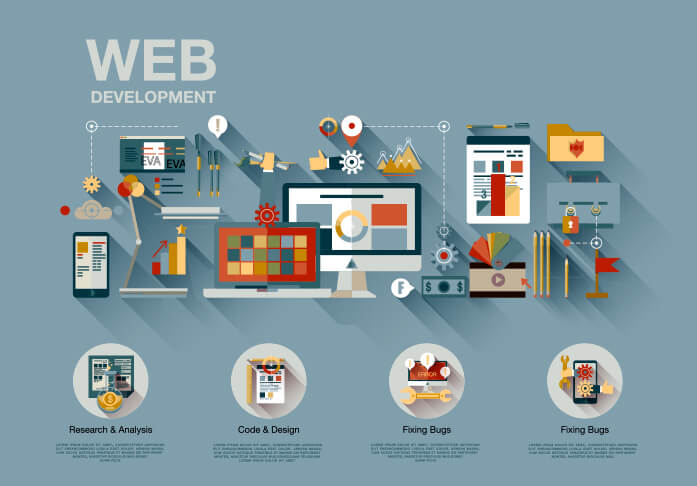Introduction
In today’s interconnected world, having a well-crafted website is essential for businesses and individuals. A website is a digital storefront that allows you to connect with potential customers, showcase your products or services, and establish your online presence. It’s a powerful tool that can help you achieve your goals, whether it’s increasing brand awareness, generating leads, or driving sales.
As technology continues to advance rapidly, so too does the landscape of website development. In 2024, we are witnessing a convergence of trends shaping how websites are designed, built, and experienced. From the rise of mobile-first design to the integration of artificial intelligence, the possibilities for creating engaging and effective websites are endless.
This comprehensive guide will delve into the key trends and best practices for website development in 2024. We will explore the latest technologies, design principles, and strategies that you can leverage to create a website that stands out from the crowd. Whether you are a seasoned web developer or a business owner looking to improve your online presence, this guide will provide valuable insights and actionable advice.
Understanding Website Development
Website development is the multifaceted process of creating, designing, and building websites. It involves a harmonious blend of technical skills and creative thinking and encompasses a range of activities from planning and designing to development, testing, launch, and ongoing maintenance.
The development process typically begins with a thorough planning stage, where the purpose of the website, target audience, content, and features are carefully defined. This lays the foundation for a successful project and ensures the website aligns with the business goals.
Once the planning is complete, the design phase takes centre stage. Designers focus on creating the website’s visual elements, including layout, colour scheme, typography, and overall aesthetic. A well-designed website not only attracts visitors but also enhances user experience and helps establish a strong brand identity.
The development phase is where the website is brought to life through coding. Developers use programming languages like HTML, CSS, and JavaScript to structure the content, style the appearance, and create interactive elements. This stage requires technical expertise and attention to detail to ensure the website functions smoothly and efficiently.
After development, the website undergoes rigorous testing to identify and address any issues or bugs. This may involve testing on different devices, browsers, and operating systems to ensure compatibility and optimal performance.
Once the testing is complete, the website is ready for launch. This involves making it public through a domain name and web hosting.
However, the journey doesn’t end there. Ongoing maintenance is crucial to keep the website updated, secure, and optimized for performance. This may include regular updates, security patches, and performance optimizations.
Website development is a collaborative effort that involves a team of professionals with diverse skills and expertise. By understanding the stages and critical activities involved in the process, you can better appreciate the complexities and challenges of creating a successful website.
Critical Trends in Website Development for 2024
Mobile-First Design: In the era of smartphones and tablets, websites not optimized for mobile devices risk losing a significant portion of their audience. The mobile-first design ensures that your website looks and functions great on smaller screens, providing a seamless user experience for mobile users.
Here are some critical considerations for mobile-first design:
- Responsive design: Your website should adapt to different screen sizes and orientations, making it easy to read and navigate on all devices.
- Touchscreen optimization: Ensure your website is optimized for touchscreen interactions, with buttons and links that are large enough to tap quickly.
- Fast load times: Mobile users have shorter attention spans, so it’s important to optimise your website for quick load times on mobile devices.
- Simplified navigation: Keep your mobile navigation menu simple and easy to use, with clear labels and logical organization.
- Optimized images: Compress images to reduce file size and improve load times on mobile devices.
By following these guidelines, you can create a mobile-friendly website with a great user experience for your visitors.
Progressive Web Apps (PWAs): PWAs are a revolutionary new approach to website development that combines the best of both worlds: the speed and reliability of native mobile apps with the flexibility and accessibility of traditional websites. They offer a seamless user experience by providing features like offline functionality, push notifications, and home screen installation. This means that users can access your website without an internet connection, receive timely updates, and add it to their home screen for quick and easy access. PWAs are built using modern web technologies like HTML, CSS, JavaScript, and the Service Worker API, which enables them to cache content and function offline. This improves the user experience and enhances SEO and website performance.
Artificial Intelligence (AI) and Machine Learning: AI and machine learning revolutionise how websites are designed, built, and experienced. By leveraging these powerful technologies, websites can become more personalized, intelligent, and efficient.
- Personalized experiences: AI-powered algorithms can analyze user data to deliver tailored content and recommendations. This helps to improve user engagement and satisfaction by providing relevant and valuable information. For example, an e-commerce website can use AI to recommend products based on a user’s purchase history and preferences.
- Improved search engine optimization (SEO): AI can help to optimize websites for search engines by analyzing search trends, identifying keywords, and suggesting improvements to content. This can help websites rank higher in search engine results pages (SERPs) and attract more organic traffic.
- Intelligent chatbots: AI-powered chatbots can provide instant customer support and answer common questions, freeing human agents to handle more complex inquiries. This can improve customer satisfaction and reduce support costs.
- Predictive analytics: AI can analyze website data and predict user behaviour. This information can be used to optimize website design, improve user experience, and identify potential issues before they arise.
Incorporating AI and machine learning into your website can create a more engaging, personalized, and efficient online experience for your users.
Voice Search Optimization: As voice search becomes increasingly prevalent, optimizing your website for voice queries is crucial. This involves using natural language and providing clear, concise information. Voice search queries are often longer and more conversational than traditional text-based searches, so it’s essential to structure your content accordingly.
Consider the following tips for voice search optimization:
- Use natural language: Write your content conversationally, mimicking how people speak. Avoid technical jargon and acronyms.
- Answer questions directly: Structure your content to answer common questions that users might ask.
- Use long-tail keywords: Long-tail keywords are more specific and often reflect the intent of a voice search query.
- Optimize for local search: If your business has a physical location, optimize your website for local search by including your address, phone number, and business hours.
- Use schema markup: Schema markup helps search engines understand the content of your website, making it more likely to appear in voice search results.
Following these tips can improve your website’s visibility in voice search results and attract more organic traffic.
Increased Focus on User Experience (UX): A positive user experience drives website traffic and conversions. This includes easy navigation, fast load times, and visually appealing design. A well-designed website makes it easy for users to find what they want and complete their desired actions. It should be intuitive, with clear calls to action and a logical flow. Additionally, a positive user experience can help to build trust and credibility, encouraging visitors to return to your website and recommend it to others.
To create a positive user experience, it’s essential to consider the following factors:
- Accessibility: Ensure that your website is accessible to people with disabilities, using features like alternative text for images, keyboard navigation, and colour contrast.
- Mobile optimization: Optimize your website for mobile devices, as many users primarily access the internet through smartphones and tablets.
- Load times: Ensure your website loads quickly, as slow load times can frustrate users and lead to higher bounce rates.
- Straightforward navigation: Use a clear and intuitive navigation menu that is easy to understand and use.
- Consistent branding: To maintain a consistent brand identity, use consistent colours, fonts, and imagery throughout your website.
- User testing: Conduct user testing to gather feedback on your website’s usability and identify areas for improvement.
Headless CMS: Headless CMS systems offer high flexibility and scalability by decoupling the content management system (CMS) from the presentation layer. This means you can update and manage your website content without affecting the front-end design. This is particularly beneficial for websites that require frequent content updates or have multiple channels (e.g., web, mobile, social media). Headless CMS systems also allow for a more agile development process, as changes to the content can be made independently of the front-end development. This can reduce development time and costs and improve time-to-market for new features and content.
Accessibility: Making your website accessible to people with disabilities is a moral obligation and a legal requirement in many jurisdictions. Accessibility features such as alternative text for images, keyboard navigation, and colour contrast can help ensure that your website is inclusive and usable by everyone.
Comparison of Popular Website Builders
Website BuilderKey FeaturesProsCons
WordPress is open-source, highly customizable, has a vast plugin ecosystem, affordable, flexible, and extensive community. However, it requires technical knowledge and can be slow with many plugins.
Wix Drag-and-drop interface is easy to use, Beginner-friendly, and has many templates and limited customization options, but it can be expensive for premium features.
Squarespace’s Sleek design, intuitive interface, Beautiful templates, and integrated e-commerce are More expensive than some alternatives and have limited customization.
Weebly is Easy to use, has a free plan, and has a Simple interface. It is suitable for basic websites. However, it has Limited customization options and can be slow with complex designs.
Frequently Asked Questions
- How much does it cost to develop a website? The cost varies depending on factors such as the complexity of the website, the features required, and the developer’s experience.
- What is the best website builder for beginners? Wix and Weebly are generally suitable for beginners due to their user-friendly interfaces.
- How long does it take to develop a website? The development time can range from a few weeks to several months, depending on the project’s scope.
- Do I need to know how to code to create a website? While coding knowledge can be helpful, many website builders and platforms allow you to build websites without coding.
- How can I improve my website’s SEO? To enhance your website’s SEO, focus on creating high-quality content, optimizing your keywords, building backlinks, and improving your website’s loading speed.
Conclusion
Website development is an ever-evolving field with exciting new trends emerging every year. By staying up-to-date with the latest technologies and best practices, you can create a visually appealing website that effectively achieves your goals. Whether you are a business owner, a blogger, or an individual looking to establish an online presence, website development offers a powerful platform to connect with your audience and achieve your objectives.
In 2024, the possibilities for website development are genuinely limitless. The landscape is constantly evolving, from integrating cutting-edge technologies like artificial intelligence and virtual reality to emerging innovative design trends. By staying informed and embracing these advancements, you can create a website that not only meets the needs of your audience but also sets new standards for excellence in web design and development.
Remember, a successful website is more than just a collection of pages. It is a valuable asset that can help you achieve your business objectives, build your brand, and connect with your target audience. By investing time and resources into website development, you can unlock the full potential of your online presence and position yourself for long-term success.



